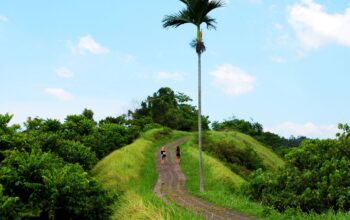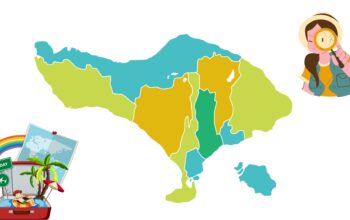Knowing Bali’s Low Season for Holidays
For those who want to vacation in Bali but don’t want to deal with traffic, queues, or prices that break the bank, the quiet season, or low season, can be the best time to visit. But when exactly is the low season? What are the advantages of vacationing when Bali is quiet? Let’s discuss it thoroughly in this article!
What is Low Season?
Before discussing further, let’s understand what “low season” means. Low season is a period when the number of tourists visiting Bali is relatively lower. This is usually because it’s not school holidays, major religious holidays, or the best weather. Because it’s quiet, many accommodations, tourist attractions, and other services offer lower prices. This is a golden opportunity for those who want to save money but still get a maximum holiday experience.
When is Bali Quiet?
Generally, there are several periods in a year that can be considered low season in Bali:
-
Mid-January to Mid-March After the hustle and bustle of Christmas and New Year holidays, Bali usually becomes quiet again. In these months, many people have returned to work or school, so the atmosphere in Bali is relatively calm. Although there might still be some rain on certain days, many also say this is the most relaxed time to enjoy Bali.
-
Mid-September to Mid-December After the busy July-August season ends, Bali enters its quiet period again. The weather tends to be good (it’s no longer the rainy season), but the atmosphere is not as crowded as in previous months. Many Europeans have returned from their summer holidays, so many villas and hotels are empty—and prices drop!
Bonus: Early Ramadan (depending on the Hijri calendar) Sometimes, when the fasting month begins, especially in its early days, Bali can be somewhat quiet. Because the majority of domestic tourists are focusing on religious observances, many postpone their holidays. However, it’s important to remember that at the end of Ramadan and during Eid al-Fitr, the atmosphere can become very crowded again.
Why Should You Vacation During Low Season?
There are many advantages to vacationing in Bali when it’s quiet. Don’t believe it? Here’s why:
-
More Affordable Prices Hotels, villas, flight tickets, and even motorbike or car rentals can be cheaper than usual. Many accommodations offer big discounts to attract guests. So, you can stay in a nicer place with the same budget, or even save a lot.
-
Free from Traffic and Queues If you’ve been to Bali during high season, you definitely know how congested the roads are in Canggu, Seminyak, or Ubud. Well, during low season, the roads are much less crowded. Traveling, taking photos, or finding a place to hang out becomes more relaxed.
-
Enjoy Tourist Attractions Peacefully Imagine sitting on Nusa Dua beach, with no noisy sounds, just the sound of waves and a gentle breeze. Or you can get good photos at Tegallalang Rice Terrace without having to wait in line. All of this is more possible during low season.
-
More Personal Service Because there aren’t too many guests, hotel or restaurant staff can focus more on serving you. Sometimes you might even get room upgrades or special promotions that aren’t available during the busy season.
-
The Right Time for Healing If your goal in Bali is to take a break from routine, find tranquility, or simply recharge your energy, the low season is the perfect time. The atmosphere is very supportive for yoga, meditation, or just a morning walk through the rice fields.
Challenges of Vacationing in the Low Season
But that’s life, there are always two sides. Vacationing in the low season also has some challenges that you need to prepare for:
-
Unpredictable Weather Some months in the low season, especially January-March, are part of the rainy season in Bali. So don’t forget to bring an umbrella or raincoat. But don’t worry, rain in Bali usually only lasts a short time—bright in the morning, rain in the afternoon, bright again in the evening.
-
Some Places Might Be Closed Due to fewer visitors, some beach clubs, bars, or restaurants might close earlier or even close completely for a few days for renovation or a break. So check before you go to avoid disappointment.
-
Not Many Events and Festivals If you like cultural events or local festivals, they are usually held more often during major holiday seasons. During the low season, such events are rarer. But this can actually be a moment for you to enjoy Bali more authentically.
Tips for a Fun Holiday in Bali During Low Season
To maximize your experience, try following these tips:
-
Find Accommodation in a Strategic Location Because prices are low, you can choose accommodation with a good location: close to the beach, close to good warungs (local eateries), or close to a yoga studio. For example, a beautiful villa in Uluwatu, or a comfortable guesthouse in Ubud.
-
Rent a Motorbike or Car Transportation in Bali can sometimes be tricky. During the low season, the roads are better for getting around, so this is your chance to try driving yourself. But still be careful, especially if it rains.
-
Take Advantage of Online Promos Many travel applications offer additional discounts during the low season. Also check the Instagram accounts of hotels or villas, sometimes there are flash sales or exclusive bundling promos.
-
Explore Hidden Spots Have you visited all the popular tourist spots? It’s time to explore unusual places. Try hidden waterfalls in North Bali, or snorkeling in Amed and Pemuteran which are calmer than Nusa Penida.
-
Make Your Schedule Flexible Low season weather can sometimes be unpredictable. So create a flexible itinerary, for example, if you plan to go to the beach today, but it rains, just switch to indoor activities like a spa or a Balinese cooking class.
Knowing the Months Considered High Season in Bali
Bali always has endless charm. But did you know that Bali also has certain times when it’s super crowded? Yes, that moment is often called the high season. If you’re a traveler who likes a lively atmosphere, many events, and wants to experience a very ‘alive’ Bali, you need to know which months are considered high season in Bali. In this article, we’ll thoroughly explore the months that are tourist favorites to visit Bali, complete with reasons why those months are crowded, plus tips to keep you comfortable traveling amidst the crowds. Let’s start!
What is High Season?
Before discussing the months, we need to understand the term “high season”. So, high season is when the number of tourists visiting Bali is at its peak. This usually coincides with:
- School or university holidays
- National holidays and collective leave
- Summer in European countries
- Year-end holidays
Because many people come at the same time, tourist attractions, accommodations, restaurants, and even roads become more crowded than usual. Prices also usually increase due to high demand. But make no mistake, the atmosphere of Bali during high season also has its own charm!
Months That Are Considered High Season in Bali
- July and August – The Peak of Summer Holidays These two months can be said to be the busiest period throughout the year in Bali. Why? Because this coincides perfectly with the summer holidays in Europe and Australia. Many foreign tourists come to Bali for long holidays.
- Atmosphere: Beaches are full, beach clubs are crowded, restaurants require reservations, and roads start to get congested, especially in Canggu, Seminyak, Kuta, and Ubud.
- Weather: It’s the brightest! Almost no rain. So it’s perfect for those who want to play on the beach, surf, dive, or walk in nature.
- Tips: If you want to come in these months, make sure to book places far in advance, especially if you’re aiming for favorite villas or hotels.
- End of December – Christmas and New Year Holidays Well, this is another super busy period. From a week before Christmas until early January, Bali is usually filled with domestic and international tourists who want to celebrate the year-end holidays.
- Atmosphere: Roads are congested, the airport is full, and there are many New Year’s Eve events at various beach clubs, hotels, and restaurants. Seminyak and Uluwatu are popular spots for New Year’s parties.
- Weather: Starting to enter the rainy season, so the weather can sometimes be unpredictable. But because the atmosphere is lively, rain sometimes doesn’t stop people from having fun.
- Tips: Prepare a plan B if your initial plan is outdoors and the weather is not supportive. Bringing a small umbrella or raincoat is also very useful.
- April (Eid al-Fitr & Easter Holidays – Depending on the Calendar) Sometimes long holidays like Eid al-Fitr and Easter fall in April. When this happens, Bali immediately gets crowded, especially with domestic tourists. Many families bring their children for holidays because it coincides with school holidays.
- Atmosphere: The airport and roads are crowded, tourist attractions are full, and some places hold special events to welcome the long weekend.
- Weather: Starting to enter the dry season, so it’s quite friendly for traveling.
- Tips: Check the national and religious calendars before departing. If you want a calmer experience, avoid long weekends.
- June and September – Transition Period But Still Busy June and early September also tend to be busy, although not as busy as July-August. This is usually because:
- Many people are taking early holidays before the peak season.
- Many promotions are still valid.
- The weather is good, not yet entering the rainy season.
- Atmosphere: Quite lively but not too crowded. Suitable for those who want a holiday vibe without being too squeezed.
- Weather: It’s at its best—bright sun but not too hot.
- Tips: This is a good time for those who want prices that are still relatively good but still get a lively holiday atmosphere.
Why Do Many People Choose to Vacation During High Season?
Even though it’s crowded, many people intentionally choose to vacation during the busy season. Why is that?
-
Many Events and Festivals During high season, there are usually many events in Bali. From music concerts, beach parties, art exhibitions, to traditional ceremonies. Bali’s atmosphere becomes more lively and exciting.
-
All Places Are Open and Active Restaurants, beach clubs, souvenir shops, tourist attractions… everything is open and usually operates with a full team. You can experience all activities and facilities without worrying about being out of luck.
-
Easier to Make New Friends If you like meeting new people or traveling alone, high season is the right time. Because there are many other tourists, you can easily meet friends from various countries.
-
General Holiday Time For many people, holidays can only be taken during school breaks or national holidays. So it’s natural that these periods become popular times to go to Bali.
Challenges of Vacationing in the Busy Season
Although exciting, vacationing in high season also has some challenges. But don’t worry, everything can be overcome.
-
Prices Increase Hotel prices, flight tickets, and even motorbike rentals can increase quite significantly. So make sure your budget is flexible enough.
-
Need to Book Far in Advance If you wait too long, your favorite accommodation might be fully booked or the prices might have skyrocketed. So, it’s better to prepare everything far in advance.
-
Traffic and Queues Bali is small, and during the busy season, the roads can be very congested. Queues at eateries, tourist attractions, and even for photos can be long. Be patient!
-
Difficult to Find Quiet Places If you’re the type who likes peace and quiet, high season might not be the best time. But you can get around this by choosing less popular areas, like Sidemen, Amed, or Tabanan.
Smart Vacation Tips for Bali During High Season
To make your vacation still fun even if it’s crowded, try following these tricks:
-
Book Everything in Advance From accommodation, flight tickets, to motorbike or car rentals, try to book everything far in advance. If necessary, restaurant reservations can also be an option so you don’t run out of space.
-
Plan an Efficient Route Avoid moving too many locations in one day. Choose nearby areas, for example, today specifically for the Canggu area, tomorrow for Uluwatu. This can reduce stress due to traffic jams.
-
Utilize Online Transportation Online motorbikes or taxis can be a lifesaver in traffic jams. But still pay attention to the pick-up location, as some areas sometimes do not allow online transport.
-
Try Activities Early in the Morning If you want to take photos without many people, try coming to tourist spots early in the morning. Besides being cooler, the atmosphere is also calmer.
-
Don’t Forget Travel Insurance Since high season is prone to delays or unexpected events, having travel insurance can help you stay calm.
Weather in Bali from January to December
For those of you planning a vacation to Bali, one very important thing to pay attention to is the weather. Although Bali is beautiful all year round, weather conditions can greatly affect your holiday experience. Well, to avoid choosing the wrong time, let’s discuss one by one, month by month, what is the weather like in Bali? And what kind of vacation is most suitable for?
January
January is usually still full of residual New Year euphoria, but it is also the month when rain often falls. This is the peak of the rainy season in Bali. The weather this month tends to be humid, and it rains almost every afternoon. Sometimes it’s hot during the day, then it rains heavily in the afternoon. However, this is also a time when Bali’s atmosphere becomes calmer because most people have returned to their work or school routines.
February
Entering February, rain still falls frequently, but its intensity begins to decrease. The sky starts to clear more often, but don’t expect blue skies every day. The beach might not always be suitable for lounging in the middle of the day because sometimes drizzles come suddenly. But this is precisely the right moment to explore Ubud or taste coffee in hidden cafes.
March – Weather Starting to Be Friendly Again
March is usually a transitional period between the rainy season and the dry season. So even though it still rains sometimes, the sun starts to appear more often. The air becomes fresh, and the trees become greener due to the previous rain. This is one of the underrated months, even though it’s actually quite good for traveling.
April
In April, the weather in Bali starts to stabilize. The sun shines longer, and rain rarely appears. Bright mornings, pleasant hot afternoons for the beach, and cool evenings for hanging out by the rice fields. This is one of the favorite months for digital nomads and backpackers.
May
May can be said to be the golden month for a vacation to Bali. Why? Because the weather is great, but it’s not too crowded yet. So you can get all of Bali’s beauty without having to jostle. Super bright, and a gentle breeze. Very suitable for those who want an active vacation.
June
June is still considered “safe” from super dense crowds. The weather has fully entered the dry season, and many tourists are starting to arrive. Blue skies almost every day, clean air, and the atmosphere is still not too chaotic. Ideal for those who like exploration but don’t want traffic jams.
July & August
Well, these two months are the high season, meaning Bali is very crowded. Tourists from Europe, Australia, and also locals come because of the summer holidays. Almost perfect! Bright from morning to evening, cool breeze, and a very lively atmosphere.
September
September is often the choice of experienced travelers. The reason? The weather is still bright, but the crowds have started to decrease. Don’t worry, prices are starting to normalize again, and tourist attractions are not as crowded as the previous two months. This is an ideal time if you want to travel but still get photo spots without waiting in line.
October
October starts to enter another transition period. Some days can be super bright, but sometimes rain suddenly comes in the afternoon. A little unpredictable, but there are still many fun activities you can do.
November
Rain starts to fall more regularly in November. But not every day, and usually only for a short time. Green everywhere, and the atmosphere becomes cooler. Tourists are also starting to decrease, so it’s suitable for those who want to rest from the hustle and bustle of the city.
December
Early December is usually quite calm. But as it approaches Christmas and New Year, the atmosphere immediately changes—Bali becomes very lively! Rain can come suddenly, but that doesn’t stop people from partying and vacationing.
Best Time to Visit North, South, East, or West Bali
Bali is vast, and each part has its own charm and best visiting time depending on your purpose. To make your vacation more enjoyable, it’s very important to know when is the best time to come to Bali according to the direction: north, south, east, or west. Let’s discuss them one by one!
South Bali
- Areas: Kuta, Seminyak, Canggu, Jimbaran, Uluwatu
- Best time: May–August South Bali is the center of crowds and tourism. If you like hanging out at beach clubs, partying, watching sunsets on crowded beaches, or surfing in Uluwatu, come during the dry season. The weather is at its brightest, skies are blue, and the waves are good for water activities. But be prepared for crowds, especially in July–August.
North Bali
- Areas: Lovina, Singaraja, Munduk
- Best time: April–October North Bali is calmer and more natural. There are waterfalls, lakes, plantations, and quiet beaches like Lovina. Suitable for healing or exploring nature. Since the terrain has many mountains and valleys, come during the dry season so the roads are not slippery and are easily accessible.
East Bali
- Areas: Amed, Tulamben, Candidasa
- Best time: May–October The eastern region is suitable for those who like diving or looking for an authentic Balinese village atmosphere. The seawater in Amed and Tulamben is super clear during the dry season. So for snorkeling or diving, avoid the rainy season because visibility can be reduced and waves are larger.
West Bali
- Areas: Pemuteran, Gilimanuk, Menjangan
- Best time: May–August West Bali is a paradise for nature and conservation lovers. You can explore West Bali National Park or snorkel at Menjangan Island. Since access to this area is quite far, it’s best to come when the roads are dry and the weather is good, which is during the dry season.
Best Time to Find the Cheapest Flight Tickets and Accommodation to Bali
Want to vacation in Bali but your wallet is thin? Don’t worry, you can still enjoy the beauty of the Island of the Gods without spending a lot of money. The key? Knowing the right time to find cheap flight tickets and accommodation. Let’s look at the tips!
-
Avoid Holiday Seasons and Public Holidays Usually, flight ticket and hotel prices will increase drastically during school holidays, Eid al-Fitr, Christmas, and New Year. If you are flexible, try to avoid June–August and mid-December to early January. In addition, long public holidays often cause prices to skyrocket.
-
Book During “Quiet” Times If you want to save money, February, March, May, October, and November are the best times. In these months, Bali tends to have fewer visitors, so there are many ticket promotions and accommodation prices are also more affordable. The weather is also quite good, even though there is sometimes light rain.
-
Look for Flight Tickets on Tuesdays or Wednesdays Believe it or not, flight ticket prices most often drop on Tuesdays and Wednesdays, especially at night. Many people don’t know this, so you have a greater chance of getting a lower price.
-
Book Far in Advance (If Possible) If you already know the exact date, try to book at least 1–2 months in advance. Usually, the earlier you buy, the cheaper the price. But don’t book too far in advance either, because airlines sometimes only give promos 2–3 months before departure.
-
Use Apps and Compare Prices Don’t just check one app. Compare prices on several platforms like Traveloka, Tiket.com, Agoda, or Booking.com. Sometimes there are different exclusive promotions. Don’t forget to activate promo notifications too, who knows there might be a sudden flash sale!
Several Special Festivals or Events to Note When Choosing a Holiday Time in Bali
Vacationing in Bali is always exciting, but to make the experience even better (or not a disappointment), it’s very important to know what events are taking place when you’re there. Sometimes there are exciting festivals, but sometimes there are also ceremonies that cause tourist attractions to close. Here are a few things you need to pay attention to:
-
Nyepi Day Nyepi is a major Hindu holiday in Bali celebrated with a 24-hour activity fast. Everyone, including tourists, is not allowed to leave their homes or hotels, lights must be turned off, and the streets are completely deserted. It usually falls around March (the date changes every year). If you are not ready for a holiday in total silence, it’s better to avoid this date. But if you want a unique experience, Nyepi can actually be a wonderful moment for reflection and a break from the hustle and bustle.
-
Galungan and Kuningan These two celebrations occur every 210 days (Balinese calendar), and are usually celebrated for 10 days. You will see many janur (penjor) decorations along the roadside and a strong religious atmosphere. Some places might be closed because residents are focusing on prayer, but for those who like culture, this is an interesting time to visit.
-
Ogoh-Ogoh (Day Before Nyepi) The night before Nyepi, there is the Ogoh-Ogoh parade – giant colorful dolls that are paraded around the village. The atmosphere is very lively, exciting, and Instagrammable. But remember, this usually causes traffic jams and many places close earlier.
-
Bali Arts Festival (Pesta Kesenian Bali) Held every mid-June to July, this is the largest cultural festival in Bali. You can see traditional dance performances, art exhibitions, and even traditional costume parades. If you are an art and culture lover, you must come during this event!
-
Music Events and International Festivals Sometimes there are big events like Ultra Beach Bali, Bestival Bali, or international yoga festivals in Ubud. They are exciting, but hotels and tickets can sell out quickly and prices can increase. So if you’re not interested in attending these festivals, it’s better to choose another time.
Specific Times That Are Better for a Family Vacation to Bali with Children
Taking children on holiday to Bali is a lot of fun, but to keep everyone comfortable and safe, it’s important to choose the right time. This is because the weather, crowds, and atmosphere can affect your family’s holiday experience.
-
Avoid the Rainy Season If you’re bringing small children, it’s definitely better if they can play outside without fear of getting wet. So it’s best to avoid November to March because that’s the rainy season in Bali. Besides disrupting outdoor activities, the roads can also be slippery and uncomfortable for children.
-
The Dry Season is More Friendly The best time for a family holiday to Bali is usually between April and October. The weather is bright, so children can play to their heart’s content on the beach, in the pool, or participate in exciting activities like going to Waterbom, Bali Safari, or riding mini ATVs. The air is also not too humid, so it’s more comfortable for traveling.
-
Avoid High Season If You Want More Calm If your child easily gets fussy in crowded places, it’s best to avoid national school holidays (June–July and December). During these times, tourist attractions are very crowded, queues are long, and accommodation prices are usually higher. Choose times like May or September, which are not too crowded but still have good weather.
-
Pay Attention to the Child’s Age and Activities If your child is still a toddler, it’s better to come during the low season because the atmosphere is calm and more relaxed. But if your child is a bit older and likes outdoor activities, coming during the dry season when school is off is also fine—as long as you book far in advance!
Impact of Vacationing in Peak Season on the Overall Tourist Experience
Vacationing during peak season, or high season, is indeed tempting—the weather is at its best, there are many exciting events, and Bali’s atmosphere is very lively. But, behind the excitement, there are a few things you need to prepare for so you’re not surprised along the way.
-
Prices Skyrocket During high season (usually June–August and December), flight tickets and accommodation prices can double. If you don’t book far in advance, be prepared to spend extra budget.
-
Tourist Attractions Are Packed Beaches, restaurants, and popular tourist attractions will be very crowded. Sometimes you have to queue for a long time to take photos at Instagrammable spots, or even fight for seats at popular cafes. For those who want a quiet atmosphere, this can be tiring even before the holiday begins.
-
Transportation Is More Complicated Roads in Bali can be more congested than usual. Especially in favorite areas like Seminyak, Canggu, or Ubud. If you bring small children or the elderly, the journey can feel more tiring due to longer travel times.
-
Difficult to Get Last-Minute Bookings Want to book a restaurant, spa, or activities like snorkeling or rafting at the last minute? It might already be fully booked. So if you’re vacationing during the busy season, it’s absolutely necessary to plan everything from the start.
Best Time for Specific Activities Like Surfing, Diving, or Hiking in Bali
Bali is not just about beaches and sunsets, but also a paradise for outdoor activity lovers! From surfing, diving, to hiking—you can enjoy it all, as long as the timing is right. Let’s check the best time for each activity to make your holiday experience even more amazing!
-
Surfing – Waves Are Great During the Dry Season For those of you who love playing with waves, the most suitable time for surfing in Bali is between May and September. This is the dry season, so the skies are bright and the waves are consistent. Spots like Uluwatu, Padang Padang, and Canggu are excellent during these months. The waves are suitable for beginners to pros!
-
Diving – Clear Water and Calm Sea If you want to dive and meet colorful fish or shipwrecks in Tulamben, the best time is between April and November. In this season, the seawater is clearer and the currents are not too strong. Visibility is great for seeing the beauty of Bali’s underwater world. Avoid the rainy season because the water can be murky and less safe.
-
Hiking – Mountain Climbing When the Weather Is Good Want to climb Mount Batur or trek in Bali’s mountainous areas? Try choosing May to October, during the dry season. The weather is bright, the roads are not muddy, and the sunrise view from the mountain peak is truly amazing. Avoid the rainy season because the trails can be slippery and prone to landslides.
Conclusion
Bali is beautiful all year round, but to make your vacation more comfortable, exciting, and not break the bank, it’s very important to choose the right time according to your purpose. If you like a quiet atmosphere and affordable prices, come during the low season like February, May, October, or early December. It’s perfect for those who want to heal, travel leisurely, and be free from crowds. Conversely, if you want to experience Bali’s lively vibe, many exciting events, and don’t mind the crowds or rising prices, the high season in July–August or late December can be an option. For families with children, avoid the rainy season and peak school holidays so children don’t get fussy easily. April to June or September is usually the most suitable time. Do you like outdoor activities like surfing, diving, or hiking? The dry season (May–October) is the best time. The weather is bright, waves are stable, and hiking trails are safe from slippery conditions. And don’t forget, before you go, also check for special events or festivals like Nyepi, Galungan, or the Bali Arts Festival. It can be a unique experience, but it can also cause some places to close. The bottom line is, Bali always has something special in every season. But if you know when is the right time according to your vacation style, your trip to Bali is guaranteed to be much more memorable!










